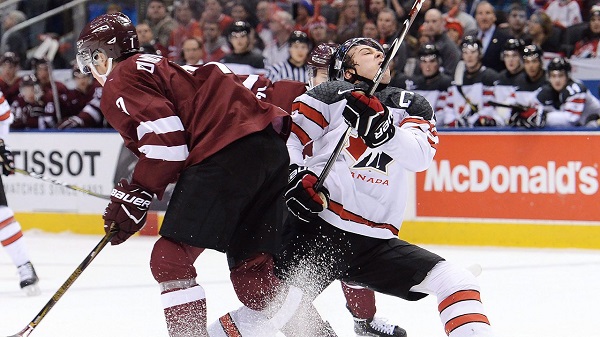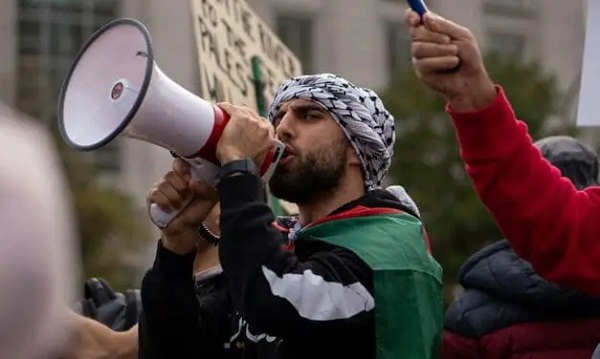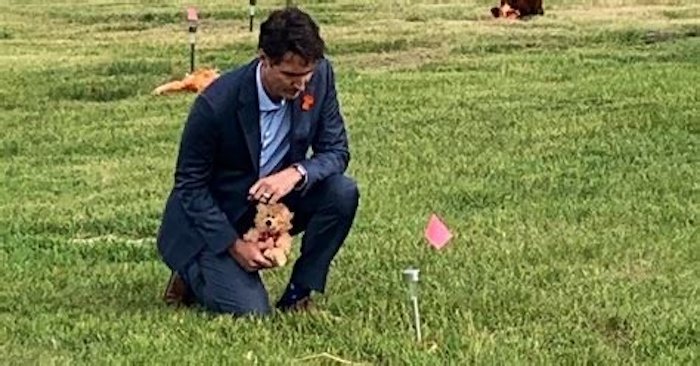Bruce Dowbiggin
Latvia Loss Reminds That World Juniors No Longer Canadian Walkover

It’s a Xmas holiday thing. With nothing better to do over the extended break Canadians watch the World Junior Hockey Championships. Little things get big very quickly. So it’s probably a good idea to put team Canada’s 3-2 SO loss to Latvia into some perspective.
After beating plucky Latvia 10-0 in a game last year, the highly rated Canadians allowed Latvia to tie this game late in the third period. Then, after a scoreless overtime session, Latvia scored the only goal of the shootout on their eighth try at Canada’s goalie, 17-year old Jack Ivankovic.
Meanwhile, Linards Feldbergs stopped 55 shots over 65 minutes before adding eight more in the shootout. For Latvia it’s the pinnacle of their hockey year. For Canada it will be quickly forgotten if they pull things back together to make the final.
But for Canadian fans on holiday, unsettled by Donald Trump jibes about making them the 51st state, the loss portends something deeper and darker. Canada has owned the tournament for much of its being, winning five golds in the past decade. But now the U.S. is suddenly king-in-waiting, winners three times in that decade, including last year. They seem a lock to win again this year (despite losing to Finland).
Meanwhile some pundits are calling this edition of Team Canada its weakest in years. Realists point out that, were it not for playing in the NHL, Canada could still have Connor Bedard, Macklin Celebrini and Carter Yaremchuck, among others, in their lineup. And yes, the quality of all the nations in the tournament has risen. This is no longer shooting fish in the barrel.
And here there might be some traction for the argument that with all its hockey advantages, Canada is not developing its elite talent properly. Generally the U.S. (or that small portion of the country that likes hockey) has adopted a hothouse strategy, concentrating its best players in exclusive development silos.

That’s the typical European soccer model, too. Elite prospects as young as 14 are brought into development programs run by top-tier teams. Canada, meanwhile, spreads its elite players over 60-plus CHL teams, second-tier junior and the NCAA. Best-on-best occurs at tournaments, but most players are trained for the unique rigours of team play and travel at the NHL level. For all the spaghetti thrown at the wall too much doesn’t stick. Or so goes the theory.
But there’s also the new reality. As we wrote upon the death of Walter Gretzky in March of 2021, “The days of amiable Ab Howe, father of Gordie, smiling benignly as his son taught himself the game are over.” Walter taught Canada how to train seriously for the Soviets. Inadvertently, he created an expensive, elite training model favouring those with true cash to train prodigies.
“As a pioneer of more sophisticated training, Walter adapted a number of the practises used by the USSR team under Anatoli Tarasov in the 1960s, drills and strategies that stood Canadian conventional thinking on its head. As I wrote in my 1998 book “Of Ice And Men”, Gretzky was unsurprised when the 1972 Soviet team swamped Canada in the early going of their Super Series.

“People said, wow, this is incredible,” Wayne Gretzky remarked later. “Not to me it wasn’t. I’d been doing this drills since I was three years old. My dad was very smart.” Among the many innovations in his Brantford backyard rink were playing Wayne on defence as a tyke so he could learn to see the entire ice and how plays developed. It also increased Wayne’s peripheral vision.
There were many more drills and insights, as Walter’s many tributes have described. Wayne has always bridled when people attributed his success simply to instinct. He always said he trained for his craft in the same way a doctor or scientist might train. “I’ve put in almost as much time studying hockey as a medical student puts in studying medicine.” That training was often under Walter.”

Their success started a quest for the best techniques. “Power skating, off-ice training, ice rentals, new equipment, travel and coaching all became necessary to get a leg up on the competition. It was also very expensive. Having the resources to send your child to the top fitness gurus like Gary Roberts or to place them in a school like Shattuck St. Marys (as Sidney Crosby was) becomes a process costing tens— or hundreds— of thousands of dollars.
“Where the NHL was predominantly players from blue-collar backgrounds till the Euros arrived in the 1970s, today it is often constituted of young men from families of means and education. The idea of the farming father of the six Sutter brothers affording his sons’ training today is highly improbable. Today’s NHL has a number of college-educated players and products of dedicated European training.
“In that way, through no fault of Walter Gretzky, hockey has become a sport for families of means or friends with means. He taught parents that the proper training and equipment was imperative. And that doesn’t mean simply the rink in your backyard. With a new pair of skates costs $500, a stick costs $125 or a set of goalie equipment runs into a few thousand dollars you are losing a segment of the population to financial costs. And so Walter’s legacy of training development if forever tied to a big price tag.”
Players in other nations observed the same, too, and soon were applying intensive training methods from soccer and other sports. No wonder Canada is no longer gets walk-overs from the midrange nations.
Bruce Dowbiggin @dowbboy is the editor of Not The Public Broadcaster A two-time winner of the Gemini Award as Canada’s top television sports broadcaster. His new book Deal With It: The Trades That Stunned The NHL And Changed Hockey is now available on Amazon. Inexact Science: The Six Most Compelling Draft Years In NHL History, his previous book with his son Evan, was voted the seventh-best professional hockey book of all time by bookauthority.org. You can see all his books at brucedowbigginbooks.ca.
Bruce Dowbiggin
Carney Hears A Who: Here Comes The Grinch

It’s a big day for the Who’s of Whoville. Mayor Augustus Maywho is now polling at 62 percent approval. Cindy Lou Who and Martha May Whovier can barely contain their trans-loving heart that finally the Pierre The Grinch is done.
Okay it’s not WhoVille. It’s Canada and it is leader Mark Carney who’s zooming in the polls against Pierre Poilievre. But it might as well be the real nation that Carney commands today. As 2025 comes to a conclusion Donald Trump seems the least of Whoville’s perils. For example:
The NDP government in B.C. has now declared that future legislation must be interpreted through the lens of the United Nations Declaration on the Rights of Indigenous Peoples. According to Chief Bent Knee (David Eby) this means that the province cannot act independently of the progressive diktats of Sudan, Nepal, Moldova and other international titans. Having been informed of Canada’s “genocidal” behaviour by Trudeau in the Rez Graves pantomime, the UN folk will no doubt look on Canadians as worthy of punishment.
The UNDRIP menace has been around since the days when Skippy Trudeau was wielding the mace in Parliament. On June 20, 2021 the federal government passed UNDRIP into law by a vote of 210 to 118. (The Liberals, NDP and Bloc all voted in favour.) The only party that opposed it were the Conservatives. In defence of those hapless boobs none of them voting yes ever expected a province to align itself with such legislation. That’s the Canadian way. Act on conscience. Retract on self preservation.

But on the heels of Eby’s unopposed capitulation to B.C.’s many “peoples” in recent land settlements, ones that threaten the legal right to properties of home owners, the wholesale framework for governing the province now will be determined by appeal to the UN.
The Carney crew — who act as though Canada’s indigenous communities are now equal partners in Confederation— assure Canadians that judicious lawyering by government savants has everything under control, but anyone trusting the Liberals after the past decade is in need of counselling.
The B.C. conundrum plays into another of the challenges (read: disasters) faced in B.C. by the Elbows Up brigade. Namely the much-heralded memorandum of understanding on energy policy between the feds and Alberta. Canadians were assured by Ottawa that this federal government sees pipelines as a priority, and getting Alberta’s product to tidewater as an urgent infrastructure need. Carney described the MOU as if it were a love-letter to the restless West. How is he going to get pipelines through to the B.C. coast when Eby and the indigenous said it was a no-go? Trust us, said Carney.

Before you could say Wetaskiwin dark clouds gathered on the deal. Smith took it in the ear from Alberta separatists for compromising anything to the feds. Carney, meanwhile, ran into the predictable roadblock from B.C. Eby talked of maybe allowing pipelines in the future, but the ban on shipping off the province’s shoreline was verboten.
To test the resilience of the MOU the federal Conservatives (remember them?) put forward a motion to build the pipeline from Alberta to the B.C. coast. Even though the motion used the same language of the MOU between Danielle Smith and Mark Carney, the Liberals and their hand maidens defeated the motion. Carney himself abstained because, hey look at that shiny object.
Immediately the Trudeaupian Deflection Shield was employed. Here’s Liberal Indigenous Service minister and proud Cree operative Mandy Gull Masty “Today’s motion that’s being put on the floor is not a no vote for the MOU. It’s a no vote against the Conservatives playing games and creating optics and wasting parliamentary time when they should be voting on things that are way more important.”
Robert Fife, the highly rated G&M scribbler who just won some big award, led the media pack, “Conservatives persist with cute legislative tricks, while the government tries to run a country.” Run a country? Into the ground?
Let’s not forget the $1.5 billion bloviators at CBC. They, too, say the vote is a big loss for the Tories. “It risks putting them offside, what is a very top priority and frankly, was considered a big win for Alberta Premier Danielle Smith.’” said Janyce McGregor. Here’s Martin Patriquin on one of the Ceeb’s endless panels. “It’s embarrassing, man. I don’t see any sort of political advantage to what happened today.”
Embarrassing? The Libs have committed to re-building gas pipelines in Ukraine, even as they stall on developing pipelines in Canada. Luckily CBC washrooms have no mirrors. And there’s always Donald Trump to deflect from the pantomimes of Canadians Laurentian debating club.
Here, CTV hair-and-teeth Scott Reid is nursing a Reuters poll that has Trump’s approval at historic lows of 36 percent. Reuters is a firm that predicted Kamala winning the presidency. Until she didn’t on Nov.4. Meanwhile Rasmussen, which correctly had Trump ahead the entire campaign, has his current approval at 44 percent while the RCP average is 43.9.
But corrupt data to make Trump seem odious is no sin in WhoVille Ottawa. Keep feeding the Karens bad data. At least Canadians have their beloved healthcare to fall back on. Or maybe their beloved MAID. A Saskatchewan woman suffering from parathyroid disease has revealed that she is considering assisted suicide, because she cannot get the surgery she needs.
“Jolene Van Alstine, from Saskatchewan, has extreme bone pain, nausea and vomiting. She requires surgery to remove a remaining parathyroid, but no surgeons in the province are able to perform the operation. In order to be referred to another province for the operation, Van Alstine must first be seen by an endocrinologist, yet no Saskatchewan endocrinologists are currently accepting new patients.
The pain has become so unbearable that she has been approved for Canada’s euthanasia and assisted suicide program, with the ending of her life scheduled to take place on 7 January 2026.”
Well. Happy New Year, Canada. May no one offer you MAID in the next twelve months.
Bruce Dowbiggin @dowbboy is the editor of Not The Public Broadcaster A two-time winner of the Gemini Award as Canada’s top television sports broadcaster, his new book Deal With It: The Trades That Stunned The NHL And Changed hockey is now available on Amazon. Inexact Science: The Six Most Compelling Draft Years In NHL History, his previous book with his son Evan, was voted the seventh-best professional hockey book of all time by bookauthority.org . His 2004 book Money Players was voted sixth best on the same list, and is available via brucedowbigginbooks.ca.
Bruce Dowbiggin
Wayne Gretzky’s Terrible, Awful Week.. And Soccer/ Football.

Inquiring minds want to know: Why did FIFA (Federation of International Fraud Artists) award American president Donald Trump a new “Peace Prize” at the Washington D.C. draw for the June/ July tournament? The usual suspects are paralyzed with rage. Everyone else is laughing at the kabuki theatre stunt.
The short answer is that if you were FIFA and you were receiving a reported billion or more dollars from the U.S. and the Canadian/ Mexican cities hosting the 48-team tournament you’d give the host more than a bottle of wine and flowers as a thank-you. Thus the ugly statue and the Boy Scout medal. The obsequious awarding of the prize and match medal were proportionate to the greed of FIFA in extorting the cash.
(America’s fainting goat media immediately complained about unearned awards for little virtue, forgetting as usual that the Nobel folks gave Barack Obama a Peace Prize after nine months in the White House for simply being a black man.)
Trump getting a peace award from FIFA, the most corrupt sports body in the sports world, is mint, however. You can’t write this stuff. (They should give it to him on a speed boat heading across the Caribbean.) The Donald then playfully suggested that Americans leave the name football to the soccer folks because, you know… feet and a ball. More outrage from NFL fans.
So what was the gift for the two Canadian cities hosting games who have also coughed up plenty? Toronto says its estimated budget is $380 million for six games/ B.C. tax payers are obliged to cough up an estimated $580 million for Vancouver’s five games). For cities with, how shall we say, bigger fish to fry.
Sadly all they got was a little farce in which a delighted PM Mark Carney was allowed to Canada as the first ball to start the picking, evidently unaware that all the balls he had to select from also said Canada. Carney’s joy was tempered when he saw Mexican president Claudia Sheinbaum draw a ball that said “Mexico” while Trump— in on the fix— got one entitled “United States”.

In a final attempt to curry favour with the fleeced nations FIFA boss Gianni Infantino gathered the world leaders for a painful onstage selfie, marking the first time Trump and Sheinbaum had ever met in the (orangey) flesh. Call it National Lampoon’s Soccer Vacation.
Having exhausted itself with the peace prize falderol FIFA evidently forgot to put any more thought into the rest of the 55-minute run-up to the draw. While soccer/ footie fans around the world ground their teeth in impatience the organizers presented a combination Eurovision/ People’s choice Awards ordeal of failed cues, untranslated interviews (the Spanish translator showed up about 30 minutes late) and pregnant pauses.
Host Heidi Klum’s stunning gold dress nearly made up for her wooden repartee with comedian Kevin Hart (“not sure why I’m here”) and co-host Rio Ferdinand, former star English defender who, alas, never won the WC. But that was all an appetizer for the real low point, the introduction of global brand stars to pick the draw. NFL legend Tom Brady, NBA legend Shaquille O’Neal and NHL… er, player Wayne Gretzky.
Their task, hectored by the hosts, was to draw a ball, unscrew the thing, withdraw a nation’s name and so on. While there may have been some tension in the audience there was no appreciation of that on the screen as more clunking dialogue and curious pronunciations (Ferdinand kept referring to Group “Haitch”) landed dead on the floor.
The nadir of the ceremony—indeed of his career— was Gretzky’s contribution. Brady and O’Neal had managed to survive their task of unscrewing the ball and pronouncing a name, but Gretzky was brought low by the stage business of the balls and the nations he was forced to announce.

The clearly flustered Gretz (he insisted he’d practiced all morning) wrestled manfully with the balls. Finally the producers went with a long shot of him fumbling in the dark. Then he topped that. Gretzy apparently thinks there are countries called “North Mack-a-donia” and “Cur-ack-ow.” Other stabs at geography were almost as tortured.
Bitter Canadians could put up with him sucking up to Trump (he was mentioned as being in the crowd at the DC Xmas tree lighting) but failing geography is unforgivable. The week that started with Gretzky in a photo golfing at POTUS’s Jupiter, Florida, golf course was ending with him pummelled for his abuse of nations with different-sounding names. The Wayne Gretzky Center For Kids Who Want To Talk Good.
The moral: Never send a centre to do a netminder’s job. Makes you understand why Bobby Orr has laid low since his Trump endorsement came out.
With that bracing date with immortality disposed of the draw proceeded. We had been pounded for an hour about how great the tournament was, and finally footy fans got what they wanted. As a host Canada got a bye into the field. Their reward is playing the tenacious Swiss and, gulp, probably Italy, which is forced to qualify after playing with their food for too long. (Insert your Stanley Tucci joke.)
If not Italy then one of Wales, Bosnia and Herzegovina or Northern Ireland. Oh, right Qatar is in there too as fodder. Been nice knowing you, Canada. The Americans somehow drew a creme puff quartet of Australia, Paraguay and Slovakia, Kosovo, Turkey or Romania. Money can’t buy you love, but it can get you a warm hug from FIFA.
In the end it’ll be one of Brazil, Argentina, Germany or France for the final in the NJ Meadowlands on July 19. Maybe they’ll have a spelling bee at halftime. Or maybe they’ll bring back Trump for the final game to give him another peace prize. Just don’t ask Gretzky to announce Lothar Matthaus, Bruno Guimaräes or Gabriel Magalhäes.
Bruce Dowbiggin @dowbboy is the editor of Not The Public Broadcaster A two-time winner of the Gemini Award as Canada’s top television sports broadcaster, his new book Deal With It: The Trades That Stunned The NHL And Changed hockey is now available on Amazon. Inexact Science: The Six Most Compelling Draft Years In NHL History, his previous book with his son Evan, was voted the seventh-best professional hockey book of all time by bookauthority.org . His 2004 book Money Players was voted sixth best on the same list, and is available via brucedowbigginbooks.ca.
-

 National1 day ago
National1 day agoCanada’s free speech record is cracking under pressure
-

 Digital ID1 day ago
Digital ID1 day agoCanada considers creating national ID system using digital passports for domestic use
-

 Business1 day ago
Business1 day agoAlbertans give most on average but Canadian generosity hits lowest point in 20 years
-

 Fraser Institute1 day ago
Fraser Institute1 day agoClaims about ‘unmarked graves’ don’t withstand scrutiny
-

 Daily Caller2 days ago
Daily Caller2 days agoUS Supreme Court Has Chance To End Climate Lawfare
-

 Business1 day ago
Business1 day agoTaxpayers Federation calls on politicians to reject funding for new Ottawa Senators arena
-

 Bruce Dowbiggin1 day ago
Bruce Dowbiggin1 day agoCarney Hears A Who: Here Comes The Grinch
-

 International1 day ago
International1 day ago100 Catholic schoolchildren rescued, Nigeria promises release of remaining hostages









